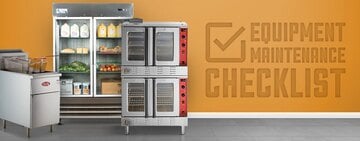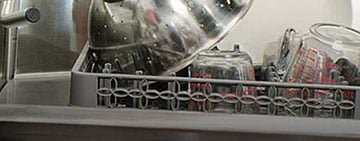
Commercial dishwashers are powerful machines that make cleaning and sanitizing your dishware much easier. However, if you don't use best practices when using and loading the dish machine, you might not be happy with the results. No matter how well the dishwasher works, the operator must still perform some basic steps to ensure that items are cleaned and sanitized the right way. If you're seeing food debris or grease on your clean dishware, it's not necessarily the fault of the equipment. Keep reading to learn how you can get the most out of your dishwasher by prepping and loading dishware properly.
1. Start the Dishwasher

Follow these steps to get your commercial dishwasher ready at the beginning of the shift:
- Check the Detergent Levels: Take a look at the detergent and rinse aid levels to make sure they are full. The detergent is responsible for breaking down grease, food particles, and stains on dishes. Without the proper amount of detergent, your dishes may not be cleaned effectively, leading to the risk of cross-contamination and unsanitary conditions.
- Make Sure the Interior Is Clean: The last employee to use the dishwasher should have cleaned it before shutting it down, but it's a good practice to always check for cleanliness before running a cycle. Inspect the scrap basket to confirm it's been emptied from the last shift. Remove any debris or food particles to prevent clogs.
- Close the Drain Valve: Running the dishwasher with the drain valve open can cause the machine to malfunction. Excess water draining out can disrupt the dishwasher's cycle, leading to incomplete cleaning and potential damage to the equipment.
- Let the Dishwasher Fill: Many commercial dishwashers need to fill with water before you run the first cycle. Close the dishwasher door, start the machine, and select the water-filling option. This takes a few minutes to be complete, so make sure to give yourself time to start the machine properly before sending any dishes through.
2. Prep the Soiled Dishware and Utensils

A common misconception is that you can load up a dishwasher with soiled dishes and it will rinse away all the food particles while cleaning and sanitizing perfectly. This is not the case. It's crucial to prep the dishes before sending them through a dish cycle so that the hot water and detergents can do their job properly. Follow these important steps when you use a commercial dishwasher for the best results:
- Scrape Away Food Particles: First and foremost, always scrape off any excess food residue from plates, bowls, and utensils. This step helps prevent clogs in the dishwasher and ensures that the cleaning process is more effective. If you fail to scrape the dishes, food particles will collect inside the dishwasher and affect future cycles
- Pre-Rinse the Dishware: Next, give the dishes a good rinse with a spray arm to remove any remaining food particles. While commercial dishwashers are powerful, pre-rinsing is necessary to improve the overall cleanliness of your items.
- Separate and Organize Items: This is where a dish table comes in handy. During a shift, you'll start collecting various types of dishes as servers clear tables and cooks deposit soiled pots and pans in the dish area. A dish table provides space for you to separate soiled items by type and stage them for cleaning.
- Handwash Only: Be mindful of what items need to be handwashed. Delicate glassware, sharp knives, and certain types of cookware may not be suitable for the dishwasher, so set them aside for manual cleaning in a three-compartment sink.
3. Load the Dishwasher

Knowing how to load a commercial dishwasher properly is key to achieving optimal results. Here are some tips to make sure your dishes come out sparkling clean every time:
- Choose the Right Dish Rack: Select the appropriate dish rack for the items you are washing. Different dishes and utensils require specific racks to hold them securely in place during the wash cycle. For example, glass racks are designed to hold your glassware and prevent breakage.
- Place Items Properly: Glassware should be placed in the rack facing down. Arrange flatware in the basket with handles down, except for anything with a sharp edge, which should be placed with the handle up for safety. Pots, pans, and bowls should be placed in the rack facing down so they drain properly.
- Avoid Overcrowding the Rack: Do not overcrowd the dishwasher racks, because this can hinder the water and detergent from reaching all items effectively. Proper spacing allows for better water circulation so that all items are cleaned thoroughly.
- Do Not Block the Spray Arms: Lastly, be cautious not to block the spray arms inside the dishwasher. These arms are responsible for distributing water and detergent throughout the machine, so obstructing them can result in uneven cleaning and potentially damage the dishwasher.
4. Inspect the Dishes

An important step that is often forgotten during a busy shift is to inspect the dishes coming out of the dishwasher. This is the time to catch anything that wasn't cleaned and correct the situation.
- Water spots: Check for any water spots on the dishes. Water spots can be unsightly and indicate that the rinse cycle may not have been effective. If you notice water spots, you may need to adjust the rinse cycle settings or use a different type of rinse aid.
- Stains or Residue: Inspect the dishes for any leftover food residue or detergent buildup. Residue can affect the taste of food and compromise food safety. If you see residue on the dishes, you may need to adjust the detergent dosage or check the water temperature.
- Scraps of Food: If the scrap basket inside the dishwasher becomes overloaded with food scraps, you will start to notice pieces of food clinging to your clean racks of dishes. This is a sign that you need to empty the scrap basket and do a better job at pre-rinsing your dishes.
- Damage: Check for any signs of damage on the dishes, such as chipped edges or cracks. Damaged dishes can harbor bacteria and pose a safety risk. If you notice any damaged dishes, it's important to remove them from circulation and replace them with new ones to maintain food safety standards.
Loading Dishwasher FAQ

If you want to know more about dishwasher use and loading, check out the commonly asked questions below:
What Should Be Done to Plates before Loading a Commercial Dishwasher?
First, plates should be scraped to remove food scraps and particles. After that, they should be pre-rinsed thoroughly before loading them into the dishwasher.
How Should You Load Bowls in the Dishwasher?
In a commercial dishwasher, you should place bowls upside down on an open rack or tilted down in a rack with tines. Do not nest the bowls, overcrowd them, or place them right side up. If you go through a lot of bowls for soup or pasta, you may want to consider purchasing specialized bowl racks that are designed to hold bowls on their side without nesting.
What's the Correct Temperature for the Final Rinse on a High Temp Dishwasher?
To effectively sanitize dishware, the final rinse temperature on a high-temp machine should be at least 180 degrees Fahrenheit.What Should You Do With Clean Dishes before Putting Them Away?
All clean dishes, glassware, flatware, and cookware should be air-dried before being put away. Be especially careful with glassware that is just coming out of the dishwasher. It needs to properly cool before being used for cold drinks or it could shatter from a rapid temperature change.
Now that you're familiar with best practices, you can make your warewashing process as efficient as possible by investing in the right size machine for your business. Check out our dishwasher sizing guide. Choosing a model that matches your volume and usage needs ensures that your machine won't be overloaded.





